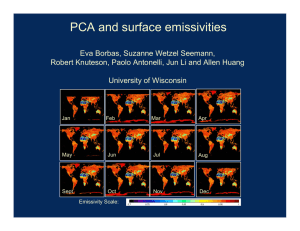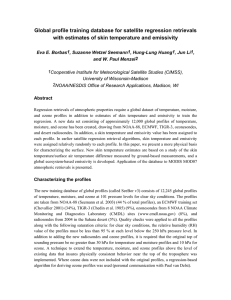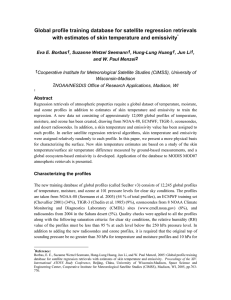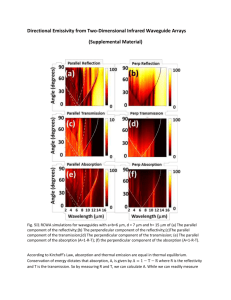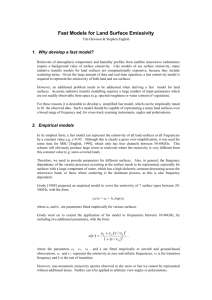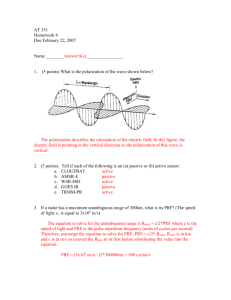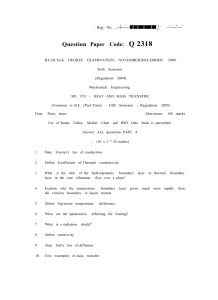Global profile training database for satellite regression retrievals
advertisement
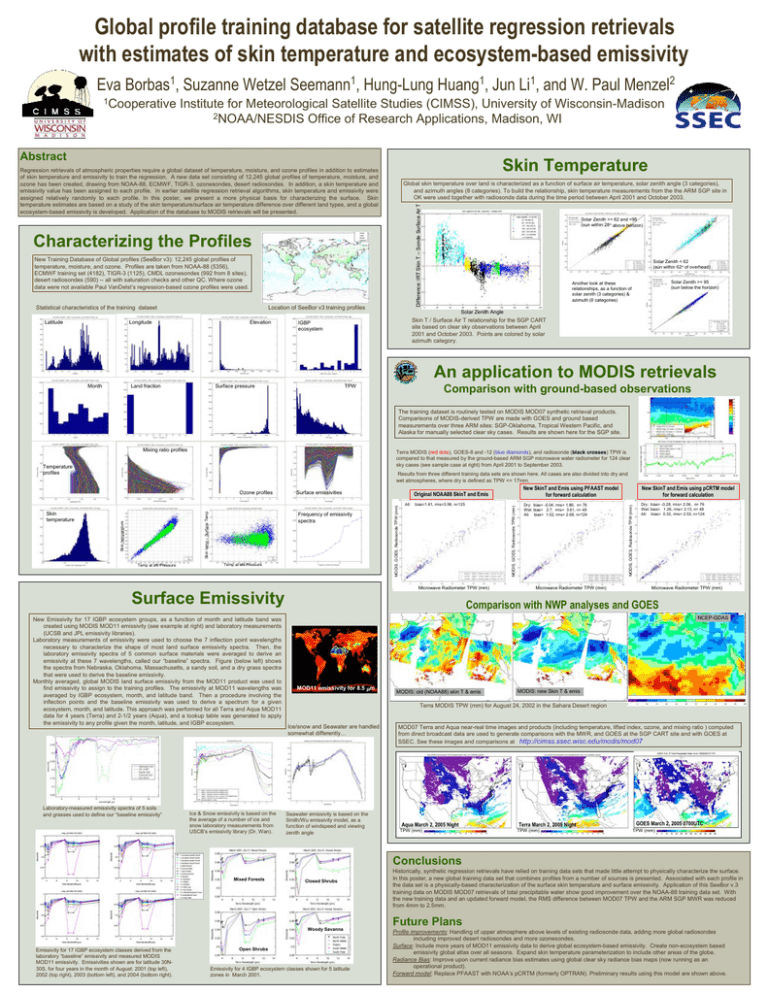
Global profile training database for satellite regression retrievals with estimates of skin temperature and ecosystem-based emissivity Eva Borbas1, Suzanne Wetzel Seemann1, Hung-Lung Huang1, Jun Li1, and W. Paul Menzel2 1Cooperative Institute for Meteorological Satellite Studies (CIMSS), University of Wisconsin-Madison 2NOAA/NESDIS Office of Research Applications, Madison, WI Abstract Skin Temperature Regression retrievals of atmospheric properties require a global dataset of temperature, moisture, and ozone profiles in addition to estimates of skin temperature and emissivity to train the regression. A new data set consisting of 12,245 global profiles of temperature, moisture, and ozone has been created, drawing from NOAA-88, ECMWF, TIGR-3, ozonesondes, desert radiosondes. In addition, a skin temperature and emissivity value has been assigned to each profile. In earlier satellite regression retrieval algorithms, skin temperature and emissivity were assigned relatively randomly to each profile. In this poster, we present a more physical basis for characterizing the surface. Skin temperature estimates are based on a study of the skin temperature/surface air temperature difference over different land types, and a global ecosystem-based emissivity is developed. Application of the database to MODIS retrievals will be presented. Difference: IRT Skin T – Sonde Surface Air T Global skin temperature over land is characterized as a function of surface air temperature, solar zenith angle (3 categories), and azimuth angles (8 categories). To build the relationship, skin temperature measurements from the the ARM SGP site in OK were used together with radiosonde data during the time period between April 2001 and October 2003. Characterizing the Profiles New Training Database of Global profiles (SeeBor v3): 12,245 global profiles of temperature, moisture, and ozone. Profiles are taken from NOAA-88 (5356), ECMWF training set (4182), TIGR-3 (1125), CMDL ozonesondes (992 from 8 sites), desert radiosondes (590) -- all with saturation checks and other QC. Where ozone data were not available Paul VanDelst’s regression-based ozone profiles were used. Statistical characteristics of the training dataset Latitude Location of SeeBor v3 training profiles Longitude Elevation Solar Zenith >= 62 and <95 (sun within 28o above horizon) Solar Zenith < 62 (sun within 62o of overhead) Solar Zenith >= 95 (sun below the horizon) Another look at these relationships, as a function of solar zenith (3 categories) & azimuth (8 categories) Solar Zenith Angle Skin T / Surface Air T relationship for the SGP CART site based on clear sky observations between April 2001 and October 2003. Points are colored by solar azimuth category. IGBP ecosystem An application to MODIS retrievals Month Surface pressure Land fraction TPW Comparison with ground-based observations The training dataset is routinely tested on MODIS MOD07 synthetic retrieval products. Comparisons of MODIS-derived TPW are made with GOES and ground based measurements over three ARM sites: SGP-Oklahoma, Tropical Western Pacific, and Alaska for manually selected clear sky cases. Results are shown here for the SGP site. Mixing ratio profiles Terra MODIS (red dots), GOES-8 and -12 (blue diamonds), and radiosonde (black crosses) TPW is compared to that measured by the ground-based ARM SGP microwave water radiometer for 124 clear sky cases (see sample case at right) from April 2001 to September 2003. Temperature profiles Results from three different training data sets are shown here. All cases are also divided into dry and wet atmospheres, where dry is defined as TPW <= 17mm. Temp at sfc Pressure bias=1.61, rms=3.99, n=125 Microwave Radiometer TPW (mm) Surface Emissivity New Emissivity for 17 IGBP ecosystem groups, as a function of month and latitude band was created using MODIS MOD11 emissivity (see example at right) and laboratory measurements (UCSB and JPL emissivity libraries). Laboratory measurements of emissivity were used to choose the 7 inflection point wavelengths necessary to characterize the shape of most land surface emissivity spectra. Then, the laboratory emissivity spectra of 5 common surface materials were averaged to derive an emissivity at these 7 wavelengths, called our “baseline” spectra. Figure (below left) shows the spectra from Nebraska, Oklahoma, Massachusetts, a sandy soil, and a dry grass spectra that were used to derive the baseline emissivity. Monthly averaged, global MODIS land surface emissivity from the MOD11 product was used to find emissivity to assign to the training profiles. The emissivity at MOD11 wavelengths was averaged by IGBP ecosystem, month, and latitude band. Then a procedure involving the inflection points and the baseline emissivity was used to derive a spectrum for a given ecosystem, month, and latitude. This approach was performed for all Terra and Aqua MOD11 data for 4 years (Terra) and 2-1/2 years (Aqua), and a lookup table was generated to apply the emissivity to any profile given the month, latitude, and IGBP ecosystem. Laboratory-measured emissivity spectra of 5 soils and grasses used to define our “baseline emissivity” Ice & Snow emissivity is based on the the average of a number of ice and snow laboratory measurements from USCB’s emissivity library (Dr. Wan). New SkinT and Emis using PFAAST model for forward calculation New SkinT and Emis using pCRTM model for forward calculation Dry: bias= -0.04, rms= 1.86, n= 76 Wet: bias= 2.7, rms= 3.61, n= 48 All: bias= 1.02, rms= 2.68, n=124 Dry: bias= -0.28, rms= 2.06, n= 76 Wet: bias= 1.26, rms= 3.13, n= 48 All: bias= 0.32, rms= 2.53, n=124 Microwave Radiometer TPW (mm) MODIS, GOES, Radiosonde TPW (mm) Frequency of emissivity spectra Original NOAA88 SkinT and Emis All: MODIS, GOES, Radiosonde TPW (mm) Temp at sfc Pressure Surface emissivities MODIS, GOES, Radiosonde TPW (mm) Skin temperature Skin temperature Skin temp – Surface Temp Ozone profiles Microwave Radiometer TPW (mm) Comparison with NWP analyses and GOES NCEP-GDAS MOD11 emissivity for 8.5 µm MODIS: old (NOAA88) skin T & emis MODIS: new Skin T & emis Terra MODIS TPW (mm) for August 24, 2002 in the Sahara Desert region Ice/snow and Seawater are handled somewhat differently… Seawater emissivity is based on the Smith/Wu emissivity model, as a function of windspeed and viewing zenith angle MOD07 Terra and Aqua near-real time images and products (including temperature, lifted index, ozone, and mixing ratio ) computed from direct broadcast data are used to generate comparisons with the MWR, and GOES at the SGP CART site and with GOES at SSEC. See these images and comparisons at http://cimss.ssec.wisc.edu/modis/mod07 Aqua March 2, 2005 Night TPW (mm) Terra March 2, 2005 Night TPW (mm) GOES March 2, 2005 0700UTC TPW (mm) Conclusions Mixed Forests Closed Shrubs Woody Savanna Emissivity for 17 IGBP ecosystem classes derived from the laboratory “baseline” emissivity and measured MODIS MOD11 emissivity. Emissivities shown are for latitude 30N30S, for four years in the month of August: 2001 (top left), 2002 (top right), 2003 (bottom left), and 2004 (bottom right). Open Shrubs Emissivity for 4 IGBP ecosystem classes shown for 5 latitude zones in March 2001. Historically, synthetic regression retrievals have relied on training data sets that made little attempt to physically characterize the surface. In this poster, a new global training data set that combines profiles from a number of sources is presented. Associated with each profile in the data set is a physically-based characterization of the surface skin temperature and surface emissivity. Application of this SeeBor v.3 training data on MODIS MOD07 retrievals of total precipitable water show good improvement over the NOAA-88 training data set. With the new training data and an updated forward model, the RMS difference between MOD07 TPW and the ARM SGP MWR was reduced from 4mm to 2.5mm. Future Plans Profile improvements: Handling of upper atmosphere above levels of existing radiosonde data, adding more global radiosondes including improved desert radiosondes and more ozonesondes. Surface: Include more years of MOD11 emissivity data to derive global ecosystem-based emissivity. Create non-ecosystem based emissivity global atlas over all seasons. Expand skin temperature parameterization to include other areas of the globe. Radiance Bias: Improve upon current radiance bias estimates using global clear sky radiance bias maps (now running as an operational product). Forward model: Replace PFAAST with NOAA’s pCRTM (formerly OPTRAN). Preliminary results using this model are shown above.


